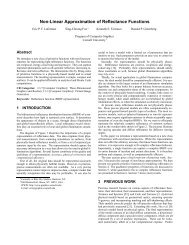pigmented colorants: dependence on media and time - Cornell ...
pigmented colorants: dependence on media and time - Cornell ...
pigmented colorants: dependence on media and time - Cornell ...
You also want an ePaper? Increase the reach of your titles
YUMPU automatically turns print PDFs into web optimized ePapers that Google loves.
effects or are too computati<strong>on</strong>ally expensive to do so interactively.<br />
As c<strong>on</strong>trasted to the previous approaches, we can work at the macroscopic level<br />
<strong>and</strong> simply model the aggregate behavior of the paint with respect to incident light.<br />
This approach was taken by German scientists Paul Kubelka <strong>and</strong> Franz Munk, who<br />
developed a simple set of differential equati<strong>on</strong>s to describe the transport of light in<br />
<str<strong>on</strong>g>pigmented</str<strong>on</strong>g> materials [KM31]. The model is very effective for <str<strong>on</strong>g>pigmented</str<strong>on</strong>g> materials,<br />
is not very complicated <strong>and</strong> is very efficient. The original paper in 1931 is based <strong>on</strong><br />
the assumpti<strong>on</strong> of a homogeneous material of a medium that is infinite in extent.<br />
The model describes the material properties of a <str<strong>on</strong>g>pigmented</str<strong>on</strong>g> material in terms of<br />
<strong>on</strong>ly two wavelength-dependent parameters: an absorpti<strong>on</strong> c<strong>on</strong>stant, K(λ), <strong>and</strong> a<br />
scattering c<strong>on</strong>stant, S(λ):<br />
106<br />
R∞ =<br />
1<br />
1+ K<br />
S +<br />
<br />
1+ <br />
K 2<br />
− 1 S<br />
(4.9)<br />
Equati<strong>on</strong> 4.9 represents the soluti<strong>on</strong> to the most basic Kubelka-Munk differen-<br />
tial equati<strong>on</strong>s as they were originally presented [KM31]. The diffuse reflectance,<br />
R∞, of a paint sample of complete hiding (a paint of a thickness such that the sub-<br />
strate cannot been seen underneath) is a functi<strong>on</strong> of the absorpti<strong>on</strong> <strong>and</strong> scattering<br />
coefficients. Note that the <str<strong>on</strong>g>dependence</str<strong>on</strong>g> <strong>on</strong> wavelength is omitted for clarity <strong>and</strong> the<br />
equati<strong>on</strong> is computed over the visible spectrum. The derivati<strong>on</strong> of the soluti<strong>on</strong>s of<br />
Kubelka <strong>and</strong> Munk’s differential equati<strong>on</strong>s <strong>and</strong> other improvements to the theory<br />
over the years are described in Appendix A.<br />
The resulting soluti<strong>on</strong>s to the differential equati<strong>on</strong>s have found wide scientific<br />
utility in areas as diverse as the study of paint, paper, textiles, <strong>and</strong> skin, as well as<br />
art c<strong>on</strong>servati<strong>on</strong> <strong>and</strong> planetary science. In computer graphics, the equati<strong>on</strong>s have<br />
been used in a variety of rendering c<strong>on</strong>texts for materials that exhibit subsurface



